Insights on Montauk Variations
March 5th, 2013So, it’s been a little over twelve months since the release of Montauk Variations on The Leaf Label, and, I discovered the following document whilst routing around for something else the other day. It’s actually a ‘score’ I had to prepare to accompany the other materials submitted for the 2012 BASCA (British Academy of Songwriters, Composers and Authors) Award (nominated by Leeds’s own living legend, Dave Hatfield). Suffice to say that it didn’t even come close to making the shortlist. Regardless, I thought that it might be of some interest here – it provides some insights into the processes and practicalities around the actual music on Montauk and, in its own way, attempts to challenge established notions of what terms such as ‘composition’ and ‘score’ actually mean in the ever-changing world of music making that surround us today. Sort of…
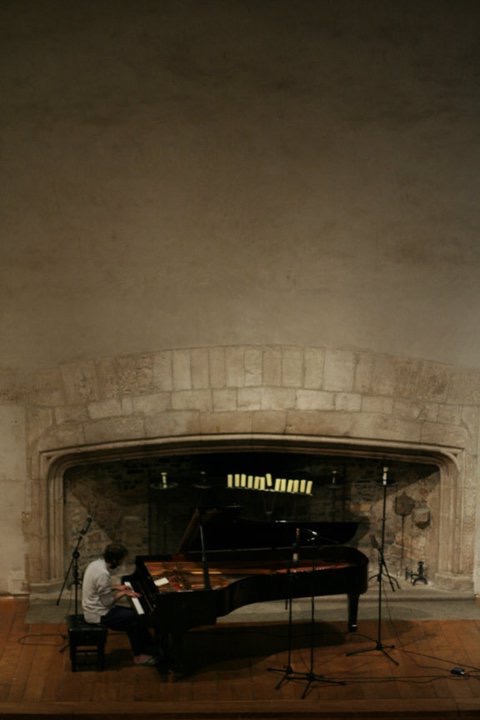
Entête
Montauk Variations is the outcome of an uncanny compulsion to visit Montauk, NY, for a few hours during August 2009 and the insights gained therein. Throughout the intervening years an embarrassing amount of time has been spent considering that this album might come to embody facets of personal unquietness, solitude and heartbreak; attributing such as the raison d’être for the music now contained herein. A realisation occurred: that this idea was bullshit.
On the occasion of recording these improvisations, fragility and romanticism seem to have outdistanced the clutter and quirkiness characteristic of previous work, owing much not only to the environs in which they were created but also to all those who believed that an exposé such as this would eventually make its appearance.
This album is for George Sidebottom, whose life has been dedicated to enriching the lives of countless others through his profound passion for music; and whose quiet patience and inspirational tutelage sought to bestow a lifelong love of music within anyone willing enough to listen. I am honoured to have been able to number myself among the many.
Thank you, George.
Reims, July 1st, 2011
Prologue
It is a privilege to have been nominated [to apply] for the BASCA Award but, as one can see from the above, it is no secret that the pieces that make up Montauk Variations are indeed improvisations. Therefore, the following discussion seeks to clarify my compositional approach as, although the act of improvisation is key to my overall methodology, it is by no means the only process at work with regard to the pieces in question (and indeed any other works in my musical catalogue).
Throughout the last ten years or so, I have developed an individual methodology that seeks to uncover the principles behind how various sounds and techniques are articulated – albeit through an intuitive practice that embraces exploration and expression through improvisation in favour of the traditional written score. I take immense pleasure from listening to and analysing scores – particularly those by C20 composers. That said, I have never felt comfortable notating my own ideas; feeling the most dissatisfied whenever I tried to control, design, compose and shape musical outcomes. Of course, the antithesis to control is to relinquish it completely, leaving everything in the hands of chance, circumstance and accident (well, almost).
I have decided against notating the pieces here (save for examples) as it would merely be a transcription of the final performance gestures, which would show little of the process or blueprint that has lead to the actual music. Combining the intuitive techniques that I have honed over the years with a firm resolve to allow factors such as particular performance/recording situations, temperature, time of day, levels of alertness/tiredness, mood, other disturbances (evidenced most notably in The Greenkeeper, discussed below), practical considerations; to become variable elements in an ‘unseen’ score; are key aspects of my practice as a performing composer. In this respect the recording of Montauk Variations IS the score and all that one is required to do is to sit back and listen….
Commentary
I. Air (for Jonathan Flockton)
Historically, I’ve often felt overwhelmed by a sort of tacit pressure to compose music that is fueled by clever technique, complexity and lack of sentiment when actually I’d rather be creating slow, unfolding music without rigourous design or intended direction. I like to think that the ghosts of Gerald Finzi (and perhaps even Peter Warlock), albeit obliquely, are lurking somewhere in the details…
II. The Mystic
This piece is really a homage to several main figures – composers Morton Feldman, Olivier Messiaen, Cyril Scott and Kaikhosru Sorabji. Over the years I have been drawn into the works of these composers for various reasons: mysticism, harmonic language, texture, sonority, Englishness… and, as mentioned previously, sometimes my investigations lead to rigourous deconstruction of compositional elements – uncovering how and why and what make certain things tick. More often than not, though, it is as simple as visually observing the various hand positions formed by playing some of the more strident dissonances of say, Messiaen (Messiaen, Olivier: Vingt Regards sur l’enfant Jésus (1944), Catalogue d’oiseaux (1956-1958)) or of Feldman’s more delicate piano writing (Feldman, Morton: Last Pieces (1959), Piano and Orchestra (1975)) and then experimenting – by forming similar hand formations which then eventually assume my own design. Such designs have been beaten into shape over the years – using only my ears as a guide, leaving a mechanism that has now become second nature. Below are two pictures that may help to illustrate this – here I am deliberately mimicking the chord shapes some of the quasi-symmetrical sonorities found in Feldman’s work:
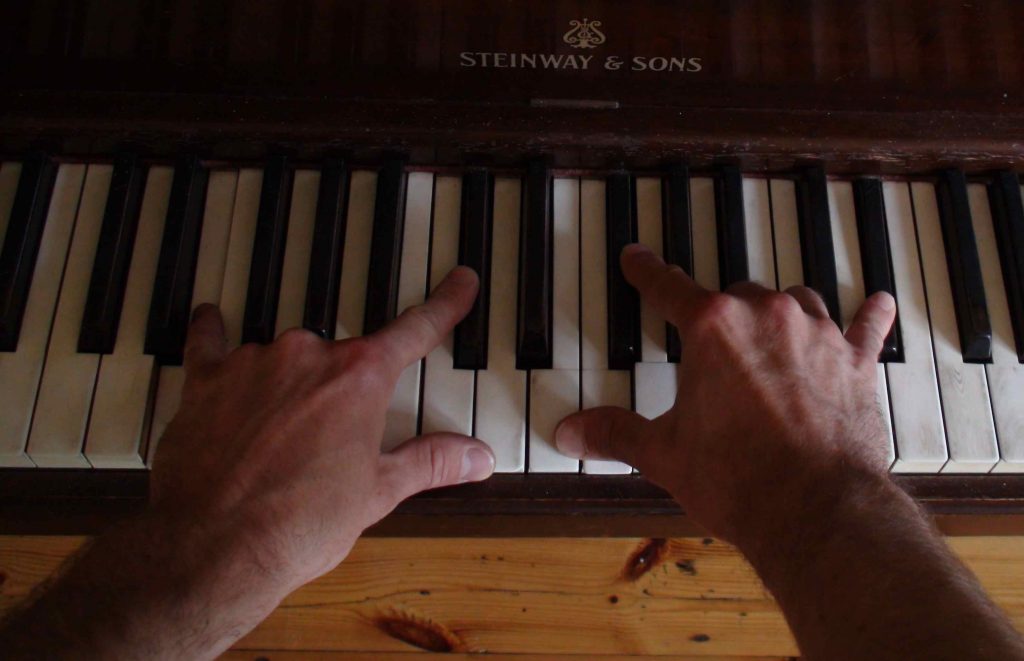
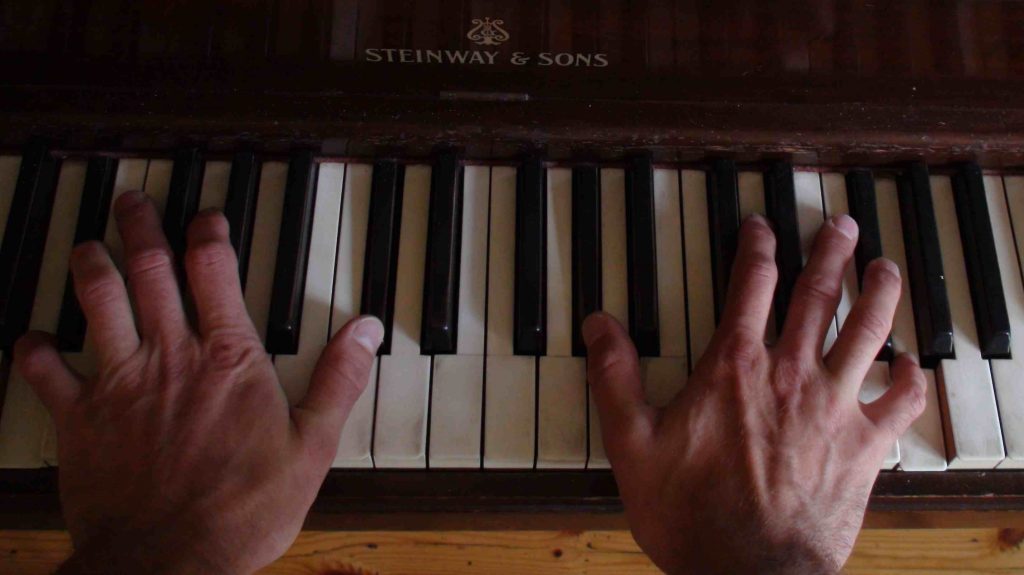
The abrupt change of pace at 02:39 is indicative of my penchant for sudden juxtaposition – marked here by the conscious introduction of this Cyril Scott-like sonority:
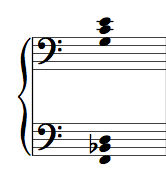
This sonority is then transposed and placed in different registers and becomes the foundation for more reflective renderings of the previous sonorities, gradually working toward the closing variations on a V-I cadence – with the V chord functioning as an ever-changing, intuitive dissonance (until I’ve had enough and decide on the final closing cadence). Some examples:

III. Phantasie
As the title suggests, this piece is indeed influenced by Frank Bridge’s more harmonically adventurous works. Phantasie was chosen from one of three recorded pieces that happened to gravitate towards various harmonic thumbprints found within many works of Bridge’s middle-to-late period (Bridge, Frank: Piano Sonata (1921-24), In Autumn (1924), A Willow Grows Aslant a Brook (1927), Phantasm: Rhapsody for Piano and Orchestra (1931)).
IV. Infinitude
This piece formed itself during a four-day recording session in March 2011 with the Belgian group, Trio Grande and, whilst sitting at the piano alone after a particularly difficult day’s recording, my hands simply ‘fell onto’ these sonorities:
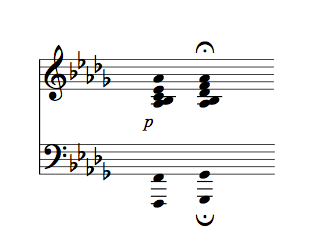
After many attempts to try and develop something more substantial, I found myself returning to simply meditating on only these two chords and realised that the development was occurring already; within the chords themselves.
This piece has become something of a practice exercise, emphasising individual notes within each chord structure to create an internal melody that is different with each rendition, leaving the phrasing/timing/pacing at the mercy of the push and pull of my own physiological and psychological tension and release. In a much broader sense, Infinitude marks the beginning of a new compositional phase, where the tacit pressure to create complex pieces has given way to simply sitting and listening.
V. Étude Pychotique (for John Zorn)
This perpetuum mobileis inspired by many hours of fruitless practice, failing miserably at producing note-perfect readings of the pinpoint freneticism of works by John Zorn (Zorn, John: Le Momo (1999)/Aporias (1994), Carl Fisher) and Salvatore Sciarrino (Sciarrino, Salvatore: Cinque Sonate per Pianoforte (1976-1994), Riccordi). I did however persist and was gradually able to transmute the same physicality required of these techniques and replace the scored notes with those of my own. As one can hear, the aim is to create an unbroken stream of notes at random and, like Infinitude, has become an exercise that I often tinker with during my practice sessions.
VI. Within
Percussive playing of the interior of the piano’s frame and strings with the hands. At this recording session, the instrument was a Bösendorfer Imperial (pictured below), exhibiting extra harmonic resonance in the bass register.
VII. One for You, Keith
Dedicated to [British] pianist and composer, Keith Tippett (whom also recorded a legendary album at Dartington’s Great Hall), this piece uses a variety of medium-to-large-sized pebbles that were found lying around in St. Margaret’s Rectory, Manchester, where the second recording session for these variations took place. The pebbles were placed on the strings of the piano and sound by either gently touching each one just enough for it to rock on the curvature of its axis, or by rocking the whole piano back and forth. The latter action educes many cracks and pops from the piano’s woodwork (particularly the legs at 0:15 and 01:15). In the picture below, the pebbles can be clearly seen to the table on the left, whilst an assortment of hymn books occupy the piano’s interior.
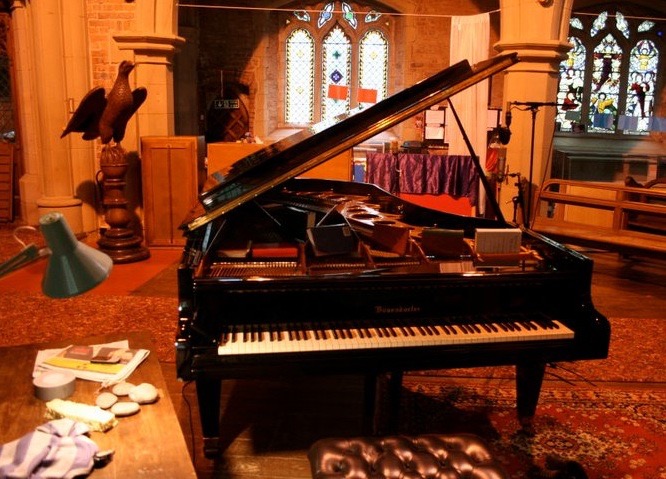
[Many similar textures were recorded in this fashion and were eventually used as the raw materials for the reinterpretation of two tracks by Amon Tobin from his album, ISAM – both of which featured on his eponymously-titled boxed set. You can read more about this process in the earlier blog, Working with Sam Hobbs: reinterpreting Amon Tobin…]
VIII. Juliet
Below is a scored fragment of the ostinato/main harmonic progression for Juliet.
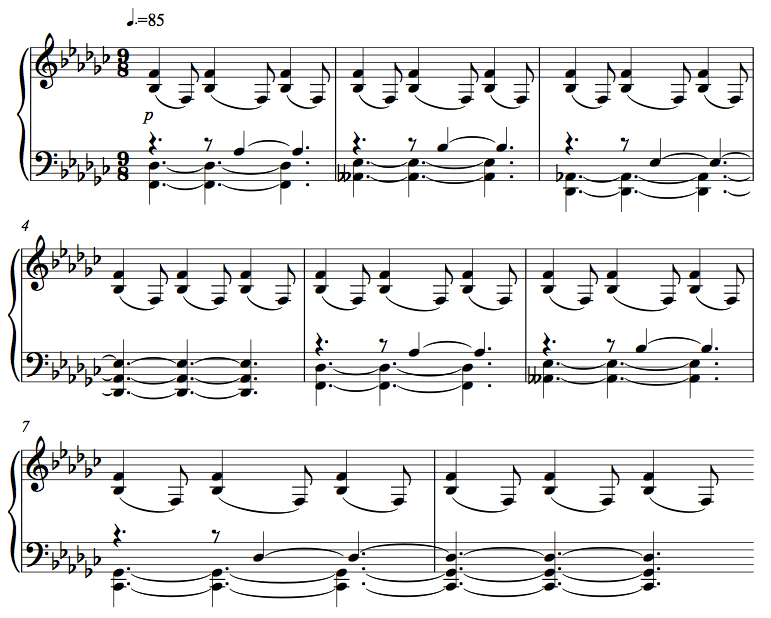
Juliet originally began life as a piano piece from the sessions that didn’t really work… A cut was made at 02:10 and pizzicato/arco cello parts were added, one by one, trying to figure out exactly what I wanted whilst doing it.
IX. Senectitude
An unused miniature I remembered from one of my sketchbooks.

X. The Greenkeeper (for Neil Dyer)
It is the drone of Neil Dyer’s lawnmower somewhere in the grounds at Dartington that penetrated into The Great Hall (one of several daytime disturbances) for the opening and closing of this piece. On realising that the drone was in fact the note ‘D’, I made this my starting point and the piece came to life instantly. The drone appeared so audible that, whilst recording, I felt distracted – producing forte sonorities with attack, not really allowing for too much decay, feeling that whatever was captured might be unusable and therefore didn’t really engage with the situation. It is amusing to think that such adverse details were responsible for unintentionally ‘setting the stage’ for this particular piece.

XI. Abrade
The sonic effects here are produced by pressing one’s fingers firmly upon the piano’s strings and pulling back very slowly (pictured overleaf). This technique is wholly dependent on the quantity of rust that has gathered on the surface of the strings (the more rust the better) and, aside from producing an abrasive sound, produces beautiful incidental harmonics.
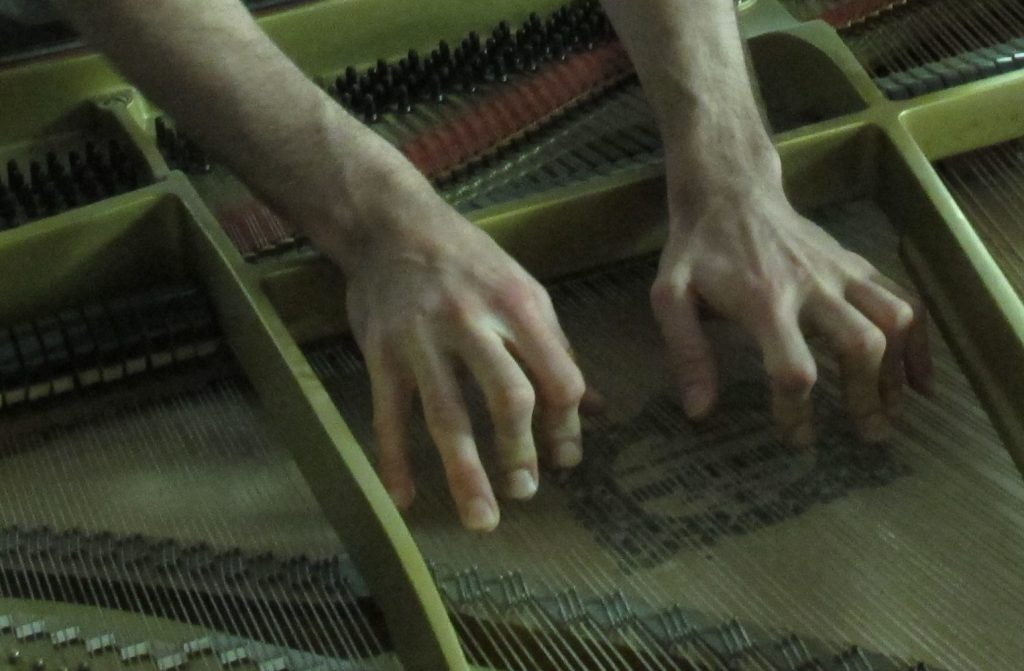
XII. Here/XIII. Gone/IV. Knell (in Memory of Philip Butler-Francis)
Here, is a cello reading of the harmonic structure of Gone, which was improvised;

as was Knell (in Eb Minor). Together they form a kind of triptych for an old departed school-friend [Philip Butler-Francis].
XV. Cuppa Tea (for Paul Bolderson)
I feel that this is an apposite moment to discuss further the practicalities mentioned earlier, as much of the tranquility and space present within many of the variations can be attributed not to the mechanisms of intention, but to aspects of a much less elegant reality: hesitation, accident, anticipation, personal doubt, lack of musical knowledge etc.; these are all aspects of an internal monologue that regulate the speed and flow of ideas as they arise. As stated earlier, my own physiological/psychological tension and release become the ritardando, fermata and tenuto markings in an invisible score. Cuppa Tea is a prime example of this, where hesitations and uncertainty account for nearly all of the decisions made. In fact, on one or two occasions I am completely on the razor’s edge (most notably between 04:41 – 04:45 where, after the last ascending passage, one can hear a sharp intake of breath…).
XVI. Unsung
It was my intention to close the variations with three, pianissimo forearm clusters, acting as an aural ‘palate cleanser’ before closing with Charles Chaplin’s composition, Smile (please see Appendix II), composed for his 1936 film, Modern Times.
Epilogue
Just as more traditional methods of scoring has allowed for the articulation and communication of musical ideas to others (not least to musicians), so therefore has the medium of recorded sound. As there is little in the way of visual signposts for Montauk Variations, I would contend that, just as a composer may take hours/days/weeks/months/years to write a work in the form of a score, improvisation is just another way of articulating those ideas that have, through years of thinking, practicing and honing intuitive methods, become embedded into one’s psyche – finding expression through a performance-based practice.
Environment and situation edit and shape the contours of these ideas and it is in the context of this arena in which they are also articulated. Of course, this is a more ‘instant’ (and arguably more impulsive) way of expressing the music, forfeiting the more established materials of sharpened pencil, paper, ruler and eraser for spontaneity, risk and the possibility of failure; but should by no means be less valid because of it. I would like to leave this commentary in the hope that, in this case, an absence of extensive notation has allowed one to focus on the sound of the music itself.
Matthew Bourne, July 4th, 2012, Bramhope.
Appendix I
Order/Structure Notes
Once the variations had been recorded/chosen, they were then ordered according to their respective start/end pitches or key signatures:
I. Air – C Minor
II. The Mystic – Atonal/end key signature, Db Major
III. Phantasie – Start note(s) Db-C. End key signature, F# Major
IV. Infinitude – F Minor/Gb Major
V. Étude Psychotique – Atonal/frenetic
VI. Within – Interior, percussive/rhythmic
VII. One for You, Keith – Stones, percussive. Plucked end note, F
VIII. Juliet – Ostinato, F & Bb. End note, F#
IX. Senectitude – First note, F#. Last note, F# (the last note to fade)
X. The Greenkeeper – First note, F#. Key signature, ‘lawnmower’ D Major
XI. Abrade – Interior, harmonics, atonal
XII. Here – C minor/Eb Major
XIII. Gone – C minor/Eb Major
XIV. Knell – Eb Minor
XV. Cuppa Tea – E Major
XVI. Unsung – Clusters, atonal
Smile – F Major
Appendix II
(This unused arrangement of Smile was originally written for a collaborative recording project with American composer and vocalist, Annette Peacock):
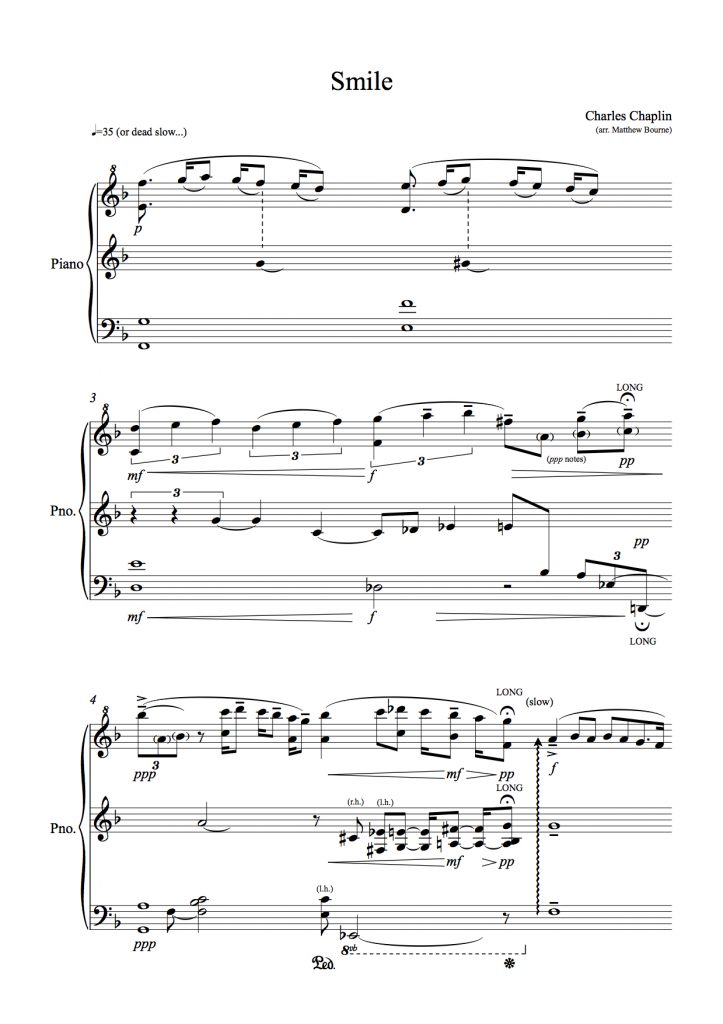
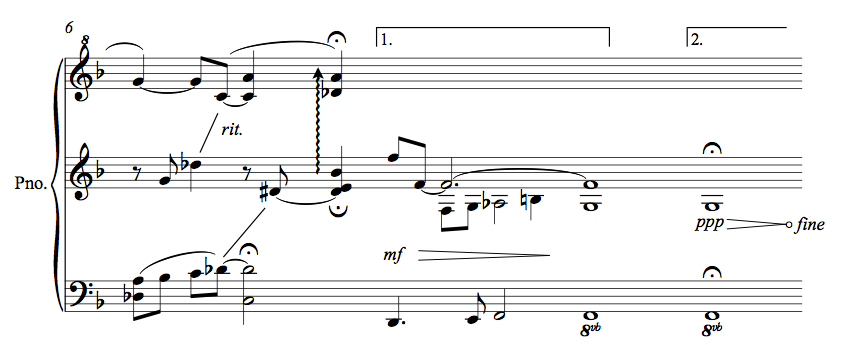
Montauk Variations is available for purchase direct from the Acquire page on the website or from The Leaf Label.